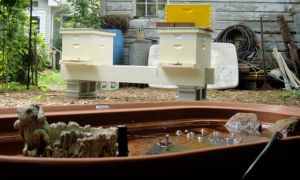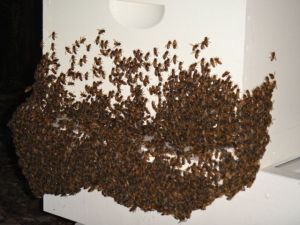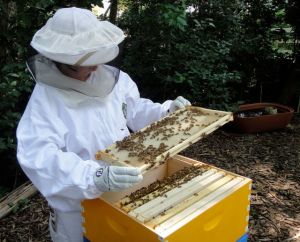The apiary was prepared, the equipment ready, and the bees had arrived in their new home. We had successfully completed Bee School, drinking in what we could from that fire hydrant of bee knowledge. Our experience with the Bee School even included being assigned bee mentors, Libby and Gerry. What a tremendously knowledgeable and patient couple. And always ready to lend a hand or provide advice. They opened up their bee yard on several occasions, and we were able to join them, along with their other bee mentees, opening up hives, looking for brood and eggs. And if you were lucky, you got to spot the queen! They taught us about inspecting the hives, proper use of the tools, how to start a smoker, and checking for bee pests like varroa mites.

Our pond, awaiting goldfish and plants, provided a great view of the hives. Note the white boxes on top of each hives. These were top feeders, used to feed sugar water to the bees. The box on top of Michigan (on the right) was the new brood box we were getting ready to put on top of a very productive Georgia Tech hive.
With such great preparation, surely we were up to whatever challenge the bees would present us. We were so starry-eyed that we even set up a pond at the far end of the apiary, stocked with plants and goldfish, for the bees to get the water they relied on to cool their hives in the hot summer. Like genteel farmers of old we were even going to set up chairs and a small table by the pond where we could sit on the warm summer evenings to admire our girls hard at work, coming close to us to sip water from our pond. That never happened . . .
As we had been taught, we faithfully started inspecting our hives every week or two, watching the progress of our girls. It was now that we started to experience the wisdom of having two hives. Georgia Tech, with its fierce yellow jacket painted on the back, grew quickly, eagerly building out comb on the new wax foundation. It was only a few weeks after we brought the bees home that we had to put the second brood box on. Even though the Georgia Tech girls had to build comb on all of the new frames, they did so without pause. And as fast as they could build new comb, the queen would commandeer it for egg-laying, producing even more followers for her domain. The population of the hive was so strong that at night, as the last foragers returned to the hive, they would find there was “no room in the inn”, and they would hang out on the outside of the hive, many clustering together and hanging from the bottom of the hive’s front porch in a practice referred to as bearding.

This shows a top feeder, opened up. The sugar water is poured into a trough on each side. The bees come up the middle, and walk down the wire mesh screen to reach the sugar water.
There was one problem with Georgia Tech though: The bees were overly defensive of their hive, resenting the intrusion of our inspection. We used the smoke which normally calms the bees nicely, but it seemed to have no impact on them. Inspections were tough, with the guard bees coming after us, seemingly as fierce as the yellow jacket painted on the back of their hive. We were well protected with our veils and bee jackets, but we had to start wearing gloves because they would sting us there. We loved their productivity, but didn’t care much for their unwelcoming demeanor.
Michigan was a different story. The bees were almost placid. We didn’t have to use much smoke, and the guard bees didn’t seem to be very concerned about us breaking into their “castle.” But the bees were too placid. They didn’t build much comb, and the queen, although laying eggs, seemed quite fine with the lack of egg-laying space. A couple of times, we saw queen cells, where the bees were trying to convert the newly hatched larva to queens. We cut the queen cells out, thinking they were trying to swarm, and we wanted to keep those girls from abandoning their new home! While this is not the preferred way to stop swarming (in fact, most beekeepers believe it will only delay the swarming, not stop it), we were sure this was the best way for us to deal with the problem.
Now what did I say about our drinking from the hydrant . . . ? When you’re drinking from a hydrant, you miss some of the water, and we obviously had not put all of the pieces together. Yes, we learned in class the difference between queen cells for swarming and queen cells for supercedure. But I guess it didn’t take. We were sure the queen cells we were seeing were swarm cells. Now wait a second . . . here’s a hive that can’t seem to build much comb, a queen that not’s laying well, and a relatively small hive population. And we thought they were trying to swarm?!?
Well, we’re a little slow, but we are trainable. After cutting out queen cells three times, we took a look at the fourth, realized it was roughly in the middle of the brood, and . . . wait a second, weren’t queen cells in the middle of the brood supercedure cells? And isn’t it possible that the bees aren’t doing well because there’s something wrong with the queen? We didn’t want to believe that. After all, she was a first year queen, and looked large enough to be a good queen. But maybe they knew something we didn’t. Maybe she wasn’t such a good queen. Maybe her pheromones–which have a lot to do with the bees and their activity–weren’t very strong, and that was why the bees seemed to be so lazy.
So we decided it was time to stop trying to control the bees, and let them manage their destiny. We put the queen cell back in the hive, closed it up, and left it alone for a few weeks, except for feeding it. When we went in a few weeks later, we found the bees were happily building comb, there was a new queen in charge, and there were lots of eggs being layed, and larva in the early stages of development. If we’d only listened to the girls sooner!
More to come . . . !
Ed







[…] A Little About Our Journey – A Tale of Two Hives (morningsidehoney.wordpress.com) […]
LikeLike